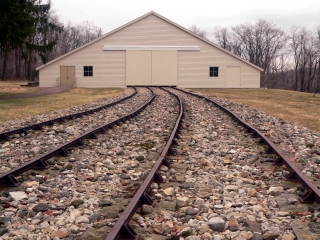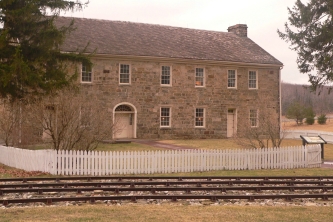NPS Website; Horseshoe Curve Website
 WHAT IS IT?
WHAT IS IT?The site of a short-lived, 1834-54, series of incline planes that pulled canal boats up and down the Allegheny Mountains.
BEAUTY (3/10)
The Allegheny Portage NHS sits along the Allegheny Mountain ridgeline. Strangely enough, its location does not equate to panoramic vistas of the surrounding countryside. Trees block one’s views in all directions. A nearby road and a distant aluminum-sided warehouse are the only things visible from the Site.
The incline plane rails are, of course, no more. About one hundred yards of re-laid rails travel into a reconstructed engine room in one direction and into grassy nothingness in the other. The Lemon House, a stone masonry tavern and inn built in 1832, is the only remnant of the past still standing. The Lemon House looks just like thousands of other constructions of its era that remain throughout Pennsylvania.
HISTORICAL INTEREST (5/10)
The Commonwealth of Pennsylvania began construction on the Allegheny Portage in 1831 in order to connect Philadelphia to Pittsburgh via canal. Our fine state had been losing its commercial traffic to the completed canals to the north (the Erie Canal) and the south (the C&O Canal). A stench of desperation hangs over this historical situation.
The far-flung engineering solution for the canal’s completion was a set of 10 incline planes designed to pull the boats for nearly 50 miles up and down the steep Allegheny Mountains. The vertical ascent from the east reached a staggering 1,400 feet. The incline planes worked well but were fraught with numerous fatal accidents and never surpassed the Erie Canal’s traffic workload.
 After just twenty years in existence, the incline planes were scrapped, making room for the far more successful railroad, and its own engineering marvel, the Horseshoe Curve. The Curve is still in use and remains a world famous destination spot for train enthusiasts.
After just twenty years in existence, the incline planes were scrapped, making room for the far more successful railroad, and its own engineering marvel, the Horseshoe Curve. The Curve is still in use and remains a world famous destination spot for train enthusiasts.CROWDS (6/10)
Few people braved the cold April weather. Summer, however, brings heavy traffic to the Horseshoe Curve site; we are sure that some of those visitors must also filter here.
EASE OF USE/ACCESS (3/5)
Two Pennsylvania Turnpike Exits (110 and 146) service the Altoona-Johnstown area. The Allegheny Portage NHS is about 50 miles from both exits, located on U.S. Route 22, near Cresson, along the ridgeline of the Alleghenies.
Temperatures are much colder here than the surrounding areas below. We prepared for a nice early spring day and arrived to 40 degrees, windy and cold.
CONCESSIONS/BOOKSTORE (3/5)
 The Portage NHS has more than a few interesting and unique titles, like The Alcoholic Republic, which examines America’s gargantuan drinking appetite in the early 19th Century, and Killing Time: Leisure and Culture in Southwestern Pennsylvania 1800-1850.
The Portage NHS has more than a few interesting and unique titles, like The Alcoholic Republic, which examines America’s gargantuan drinking appetite in the early 19th Century, and Killing Time: Leisure and Culture in Southwestern Pennsylvania 1800-1850.But what are books about Admiral Robert Peary’s trip to the North Pole doing here? Well, the daring explorer was born right here in Cresson, Pennsylvania. Who knew?
COSTS (3/5)
Entry is $4 per person, free with the National Parks Pass. Your admission also covers entry into three nearby NPS sites: the Johnstown Flood NMEM, Fort Necessity NB and Friendship Hill NHS.
Entry to the see the nearby, but unaffiliated, Horseshoe Curve and Railroaders Memorial Museum is $7.50.
RANGER/GUIDE TO TOURIST RATIO (4/5)
Two Rangers were posted in two different buildings. They were both very helpful.
TOURS/CLASSES (7/10)
We were won over by the Site’s charming film told from the perspective of a nostalgic 19th Century jack-of-all-trades. The film put us in a good mood, taught us the basics about the local history and prepped us for exploration.
The newly remodeled Visitor Center is gorgeous and encases a number of interesting exhibits, many with a focus on moving parts. We especially enjoyed the dioramic representation of the incline planes made whole by a turning engine room and climbing canal boats.
More exhibits awaited us in both the Engine Room and in the Lemon House. The Engine Room exhibits detail the technical aspects of the Portage, while the Lemon House recounts the social history.
FUN (6/10)
We had a fun time once we steeled our short-sleeve wearing selves and acclimated to the much colder than expected weather. You are not going to see the incline planes (progress took them away over 100 years ago) but you will see a reconstruction of the impressively large steam engine that provided the awesome power of the past. We really enjoyed the hands-on displays located in the engine house exhibit building.
 We also had a great time with the 19th Century children’s toys housed on a windowsill in the Lemon House. The games, while simple, are not easy. We toiled for at least ten minutes with a cast iron disentanglement toy and had more fun than allowed with the ball-tied-to-a-cup toy.
We also had a great time with the 19th Century children’s toys housed on a windowsill in the Lemon House. The games, while simple, are not easy. We toiled for at least ten minutes with a cast iron disentanglement toy and had more fun than allowed with the ball-tied-to-a-cup toy.The Site gave us reassurance that high priced large-scale transportation projects financed by the taxpayers of the Commonwealth of Pennsylvania that contribute dubious public gain are not just a modern-day phenomenon. Sure, that link was unfair, but aptly ironic since a plaque at the Allegheny Portage NHS thanks Mr. Murtha for the funding that made its new Visitor Center possible.
WOULD WE RECOMMEND? (5/10)
The Allegheny Portage NHS possesses none of the romance, historic significance or attraction enjoyed by its working iron neighbor. Altoona’s minor league baseball team is nicknamed the Curve and not the Portages, you know. But if you are an itinerate train spotter, you should accompany your visit to the Curve to see its less famous ancestor, the canal portage. This Site will put into perspective American transportation and commercial history with interesting hands-on exhibits and smaller crowds.
TOTAL 45/80
www.usa-c2c.com
© 2004-06